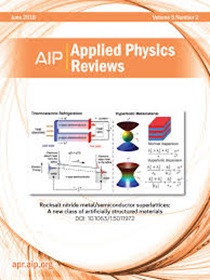由共价掺杂引起的半导体中的异常热输运
IF 11.6
1区 物理与天体物理
Q1 PHYSICS, APPLIED
引用次数: 0
摘要
掺杂或取代作为一种有效的热管理技术,已被广泛用于降低各种材料的晶格导热系数。自20世纪50年代以来,人们对等电子合金化的声子机制进行了深入的研究。最近,共价掺杂在半heusler NbFeSb体系中的特殊作用被阐明。本文以TiCoSb半heusler体系为例,结合第一性原理计算和中子衍射研究,从理论上和实验上探讨了共价掺杂降低导热系数的机理。由共价掺杂引起的声分支软化可以有效地降低声子群速度。此外,中子粉末衍射分析表明,费米能级变化引起的补偿缺陷的引入对降低声子的弛豫时间起着至关重要的作用。由于这两个因素,相邻元素的掺杂导致晶格导热系数显著降低(例如,在TiCoSb半heusler体系中,Ni掺杂在Co位),特别是在低温范围内。我们的发现为共价掺杂材料中的声子散射机制提供了有价值的见解,并证明了补偿缺陷在热传输中的作用,这适用于其他掺杂半导体系统。本文章由计算机程序翻译,如有差异,请以英文原文为准。
Anomalous thermal transport in semiconductors induced by aliovalent doping
As an effective method for thermal management technologies, doping or substitution has been extensively utilized to reduce the lattice thermal conductivity of various materials. Intensive studies have been conducted about the phonon mechanism of isoelectronic alloying since the 1950s. Very recently, the specific role of aliovalent doping was elucidated in the half-Heusler NbFeSb system. Here, we have theoretically and experimentally investigated the mechanism of reducing thermal conductivity through aliovalent doping by combining first-principles calculations and neutron diffraction studies for the case study of the TiCoSb half-Heusler system. The softening of the acoustic branches induced by aliovalent doping can effectively reduce the phonon group velocities. Moreover, the introduction of compensating defects, resulting from changes in the Fermi level, plays a vital role in decreasing the relaxation time of phonons, as demonstrated by the analysis of neutron powder diffraction. Due to these two factors, doping with adjacent elements results in a significant reduction in lattice thermal conductivity (for instance, Ni doping at the Co site in the TiCoSb half-Heusler system), especially in the low-temperature range. Our findings provide valuable insight into the phonon scattering mechanism in aliovalent-doped materials and demonstrate the role of compensating defects in heat transport, which is applicable to other doped semiconductor systems.
求助全文
通过发布文献求助,成功后即可免费获取论文全文。
去求助
来源期刊

Applied physics reviews
PHYSICS, APPLIED-
CiteScore
22.50
自引率
2.00%
发文量
113
审稿时长
2 months
期刊介绍:
Applied Physics Reviews (APR) is a journal featuring articles on critical topics in experimental or theoretical research in applied physics and applications of physics to other scientific and engineering branches. The publication includes two main types of articles:
Original Research: These articles report on high-quality, novel research studies that are of significant interest to the applied physics community.
Reviews: Review articles in APR can either be authoritative and comprehensive assessments of established areas of applied physics or short, timely reviews of recent advances in established fields or emerging areas of applied physics.
 求助内容:
求助内容: 应助结果提醒方式:
应助结果提醒方式:


